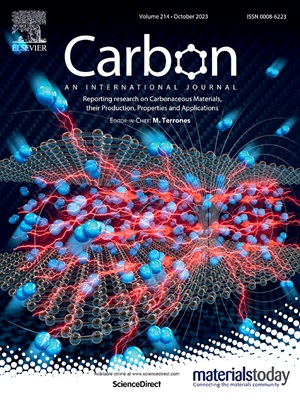碳点簇触发发光吗?通过空间相互作用排列如何影响碳点的光学性质
IF 11.6
2区 材料科学
Q1 CHEMISTRY, PHYSICAL
引用次数: 0
摘要
使用非共轭发色团的非常规发光材料,称为团簇触发发射材料(CLgens),作为一种无害环境且具有生物相容性的传统荧光团替代品,引起了相当大的关注。开发这些材料的一个主要挑战是对控制其激子形成和命运的机制的理解有限,特别是团簇彼此之间及其周围环境的相互作用。在这方面,本研究旨在通过一种创新的方法揭示团簇的光学性质,通过将非传统发光聚合物转化为碳化聚合物点(cpd),允许调整电子相互作用和团簇硬化,从而深入了解这一机制。与聚合物前驱体相比,这种类型的cpd的形成导致了通过空间相互作用(TSI)的增加,这是由于cpd形成中固有的距离减少和约束所带来的更强的空间相互作用所驱动的。更引人注目的是前体和CPDs在光谱特征上的微小差异。观察到TSI的典型光谱特征,如不同的激发和吸收光谱,发射光谱对激发波长的依赖性,以及小团簇中的蓝移发射。这些观察只能得出这样的结论:TSI是这些CPDs发光的最合理的机制。这是理解CLgens与衍生CPDs之间关系的重大突破。此外,它强调了考虑前驱体性质的重要性,以避免对这些材料的发光产生误解,并相应地调整其性质。本文章由计算机程序翻译,如有差异,请以英文原文为准。

Are carbon dots cluster-triggered luminogens? How through-space interaction arrangement influence the optical properties of carbon dots
The use of non-conventional luminescent materials without conjugated chromophores, known as cluster-triggered emission materials (CLgens), has attracted considerable attention as an environmentally benign and biocompatible alternative to conventional fluorophores. A major challenge in developing these materials is the limited understanding of the mechanisms that govern the formation and fate of their excitons, in particular the interaction of the clusters with each other and their surroundings. In this regard, this study aims to gain insight into this mechanism by unravelling the optical properties of the cluster through an innovative approach where a non-traditional luminescent polymer is converted into carbonized polymer dots (CPDs), allowing tuning of electronic interactions and cluster stiffening. The formation of this type of CPDs leads to an increase in through-space interactions (TSI) when compared to the polymer precursor, driven by stronger spatial interactions enabled by the reduced distances and constraints inherent in the formation of the CPDs. Even more striking were the small differences in spectral features between the precursors and CPDs. The typical spectroscopic features associated with TSI, such as the different excitation and absorption spectra, dependence of the emission spectra on the excitation wavelength, and blue-shift emission in small clusters, were also observed. These observations can only lead to the conclusion that TSI is the most plausible mechanism for the luminescence of these CPDs. This represents a significant breakthrough in understanding the relationship between CLgens and the derived CPDs. Furthermore, it highlights the importance of considering the properties of the precursor in order to avoid misconceptions about the luminescence of these materials, and to adjust their properties accordingly.
求助全文
通过发布文献求助,成功后即可免费获取论文全文。
去求助
来源期刊

Carbon
工程技术-材料科学:综合
CiteScore
20.80
自引率
7.30%
发文量
0
审稿时长
23 days
期刊介绍:
The journal Carbon is an international multidisciplinary forum for communicating scientific advances in the field of carbon materials. It reports new findings related to the formation, structure, properties, behaviors, and technological applications of carbons. Carbons are a broad class of ordered or disordered solid phases composed primarily of elemental carbon, including but not limited to carbon black, carbon fibers and filaments, carbon nanotubes, diamond and diamond-like carbon, fullerenes, glassy carbon, graphite, graphene, graphene-oxide, porous carbons, pyrolytic carbon, and other sp2 and non-sp2 hybridized carbon systems. Carbon is the companion title to the open access journal Carbon Trends. Relevant application areas for carbon materials include biology and medicine, catalysis, electronic, optoelectronic, spintronic, high-frequency, and photonic devices, energy storage and conversion systems, environmental applications and water treatment, smart materials and systems, and structural and thermal applications.
 求助内容:
求助内容: 应助结果提醒方式:
应助结果提醒方式:


